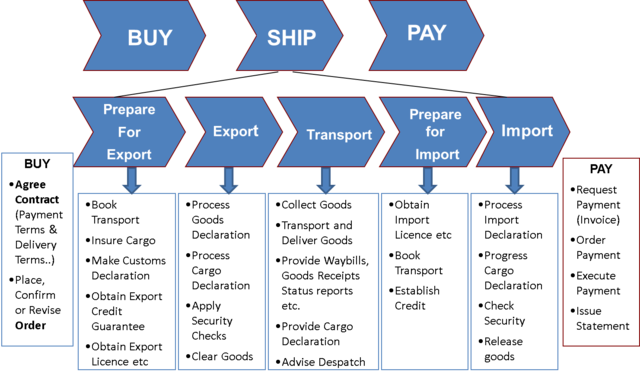The Buy-Ship-Pay Reference Models
The Buy-Ship-Pay reference models developed by UN/CEFACT describe the main processes and parties in the international supply chain and the relationship between the high-level data entities of the involved international sales and transport contracts. International supply chains ensure that goods which are traded cross-border can be ordered, shipped and paid for while complying with regulatory requirements and providing trade security.
The Buy-Ship-Pay business process reference model identifies the key commercial, logistical, regulatory and payment procedures involved in the international supply chain and provides an overview of the information exchanged between the parties throughout its various steps. The model was formally developed according to the UN/CEFACT Modelling Methodology (UMM) and is also known as the International supply chain reference model.
The Buy-Ship-Pay Reference Data Model describes the requirements for a generic reference data model supporting the trade and transport-related processes involved in the cross-border supply chain and covering, at a high-level, the involved business areas, the main parties and the information involved. It provides the framework for any cross-border transport-related business and government domains to specify their own specific information exchange requirements whilst complying with the overall processes and data structures.
The Buy-Ship-Pay Reference Data Model has taken a holistic approach to develop a reference data model based on the UN/CEFACT Core Component Library (CCL) which brings together the data exchange requirements of international cross-industry trade and multimodal transport processes including related insurance, customs and other regulatory documentary requirements. It can be applied by any country, region or industry community to provide the definitions of contextualised transport-related data exchange documents which can be integrated into software solutions for traders, carriers, freight forwarders, agents, banks, Customs and Other Governmental Authorities etc.
Relevance to trade facilitation
The Buy-Ship-Pay reference models facilitate Business Process Analysis and Data Harmonisation efforts in various ways. The Buy-Ship-Pay business process reference model can be utilized in the scope phase by providing an overview for defining local business process requirements and it can also be used during “To-Be” modelling as a template in the detailed process modelling phase.
The Buy-Ship-Pay reference data model can be used as the basis for the data harmonisation as described in UNECE Recommendation 34 which is essential in the preparation of single Window implementations. It also provides a comprehensive foundation for developing globally aligned data exchange specifications which may be required for any aspect of the international supply trade.
Business partners in international trade
The Buy-Ship-Pay model identifies four main business partner types: Customer, Supplier, Intermediary and Authority. The types or organizations that make up these four categories, and the roles they play, are described. The following list identifies the main ones.
| Customer | Supplier | Intermediary | Authority |
| Buyer | Seller | Transport Service Provider | Customs Authority |
| Invoicee | Invoicer | Bank | Environmental Agency |
| Payor | Payee | Credit Agency | Agricultural Agency |
| Importer | Exporter | Insurer | Chamber of Commerce |
| Final Consignee | Original Consignor | Customs Agent | Consular Authority |
| Transport Services Buyer | Transport Services Seller | Carrier Agent | Inspection Agency |
| Ship To | Ship From | Commission Agent | Port Health |
| Manufacturer | etc. | etc |

Business processes and business transactions in international trade
The following figure illustrates the business processes and transactions that are included in the Buy-Ship-Pay model. Only the SHIP part is shown with the two top levels. Below that level, business process views of the named transactions are stored in the model. They are more detailed, and are linked to the UN/CEFACT transaction data model.

The table shows a more detailed view of the business processes and transactions included in the Buy-Ship-Pay business process and the Buy-Ship-Pay Refence Data models.
The diagrams are provided to show the level of detail of information documented for each process in the business process models as defined in the UN/CEFACT UMM. Further details of the business processes covered by the Buy-Ship-Pay business process reference model including the important aspects of trade and transport security may be found here.
The links between the two reference models and information of the fundamental relationship between international sales contracts and their associated international transport contracts as defined by INCOTERMS including the party roles involved and the definitions and relationships between the high-level data entities can be found in the Buy-Ship-Pay reference data model business requirements specification (BRS).
